The Cambridge History of China. Vol. 13: Republican China 1912-1949, Part 2
Подождите немного. Документ загружается.

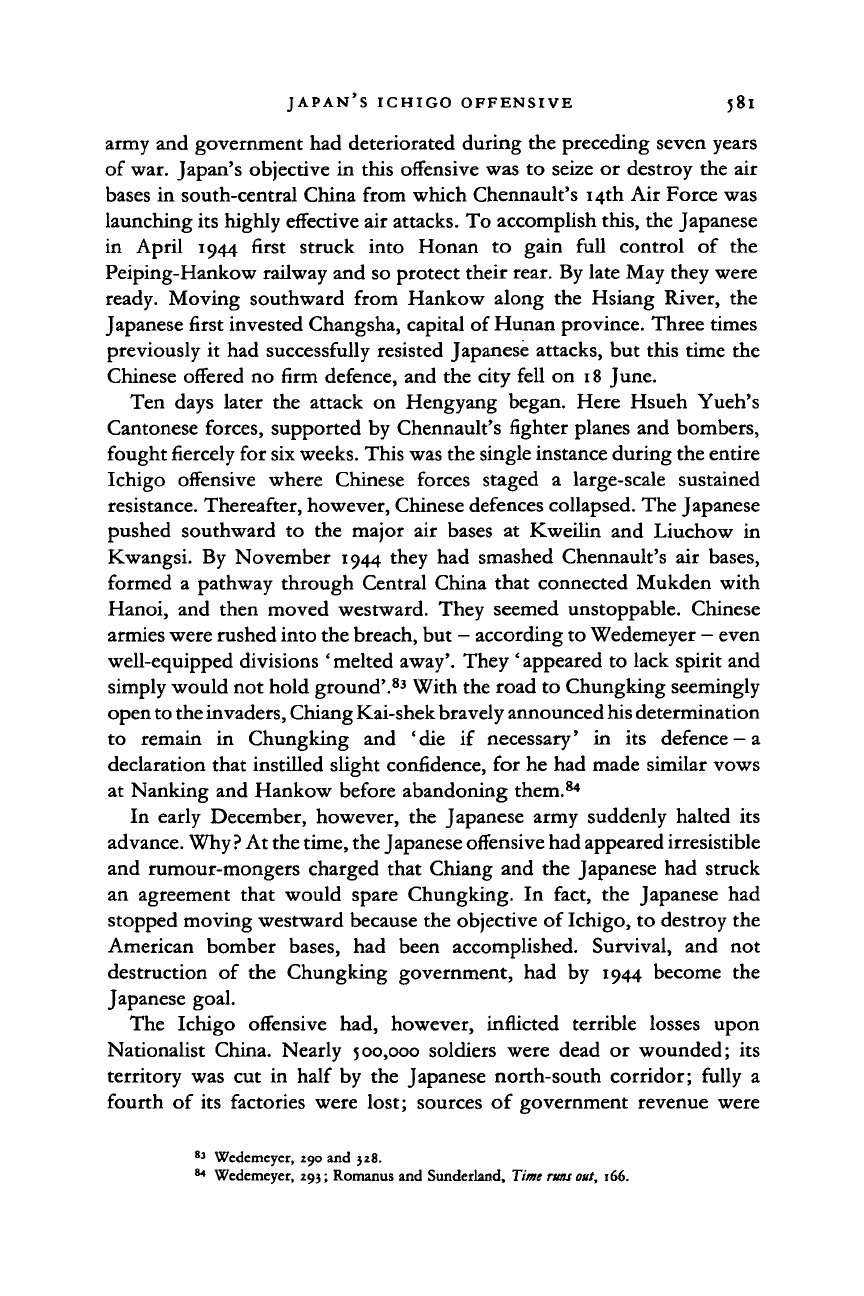
JAPAN'S ICHIGO OFFENSIVE 581
army
and
government
had
deteriorated during
the
preceding seven years
of war. Japan's objective
in
this offensive
was to
seize
or
destroy
the air
bases
in
south-central China from which Chennault's
14th Air
Force
was
launching
its
highly effective
air
attacks.
To
accomplish this,
the
Japanese
in April
1944
first struck into Honan
to
gain full control
of the
Peiping-Hankow railway
and so
protect their rear.
By
late May they were
ready. Moving southward from Hankow along
the
Hsiang River,
the
Japanese first invested Changsha, capital
of
Hunan province. Three times
previously
it had
successfully resisted Japanese attacks,
but
this time
the
Chinese offered
no
firm defence,
and the
city fell
on 18
June.
Ten days later
the
attack
on
Hengyang began. Here Hsueh Yueh's
Cantonese forces, supported
by
Chennault's fighter planes
and
bombers,
fought fiercely
for
six weeks. This was
the
single instance during the entire
Ichigo offensive where Chinese forces staged
a
large-scale sustained
resistance. Thereafter, however, Chinese defences collapsed. The Japanese
pushed southward
to the
major
air
bases
at
Kweilin
and
Liuchow
in
Kwangsi.
By
November
1944
they
had
smashed Chennault's
air
bases,
formed
a
pathway through Central China that connected Mukden with
Hanoi,
and
then moved westward. They seemed unstoppable. Chinese
armies were rushed into the breach,
but -
according
to
Wedemeyer
-
even
well-equipped divisions ' melted away'. They ' appeared
to
lack spirit
and
simply would
not
hold ground'.
83
With
the
road
to
Chungking seemingly
open
to
the invaders, Chiang Kai-shek bravely announced
his
determination
to remain
in
Chungking
and
'
die
if
necessary'
in its
defence
- a
declaration that instilled slight confidence,
for he had
made similar vows
at Nanking
and
Hankow before abandoning them.
84
In early December, however,
the
Japanese army suddenly halted
its
advance. Why? At the
time,
the Japanese offensive had appeared irresistible
and rumour-mongers charged that Chiang
and the
Japanese
had
struck
an agreement that would spare Chungking.
In
fact,
the
Japanese
had
stopped moving westward because
the
objective
of
Ichigo,
to
destroy
the
American bomber bases,
had
been accomplished. Survival,
and not
destruction
of the
Chungking government,
had by 1944
become
the
Japanese goal.
The Ichigo offensive
had,
however, inflicted terrible losses upon
Nationalist China. Nearly 500,000 soldiers were dead
or
wounded;
its
territory
was cut in
half
by the
Japanese north-south corridor; fully
a
fourth
of its
factories were lost; sources
of
government revenue were
83
Wedemeyer, 290 and 328.
84
Wedemeyer, 293; Romanus and Sunderland, Time runt out, 166.
Cambridge Histories Online © Cambridge University Press, 2008
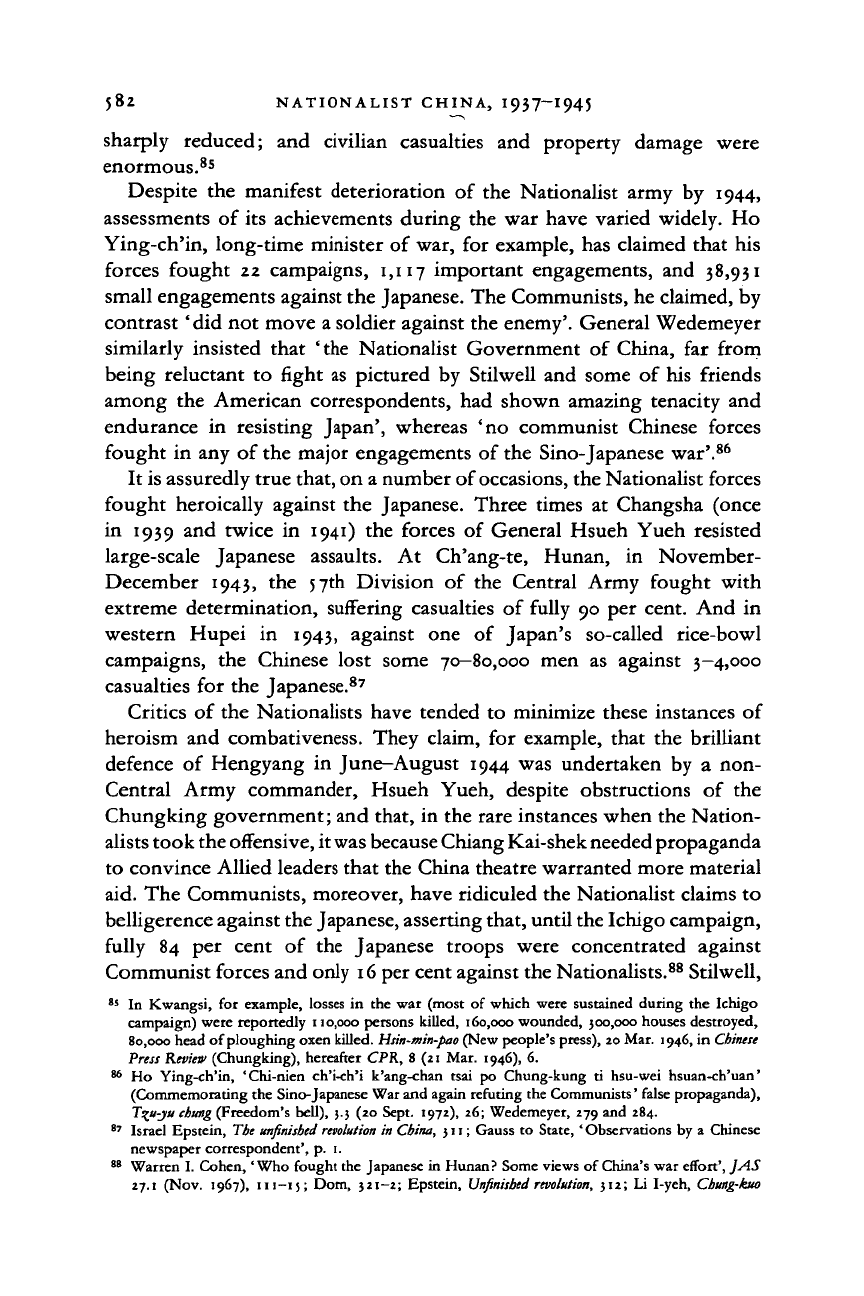
582 NATIONALIST CHINA, 1937-1945
sharply reduced;
and
civilian casualties
and
property damage were
enormous.
85
Despite
the
manifest deterioration
of
the Nationalist army
by
1944,
assessments
of
its achievements during the war have varied widely.
Ho
Ying-ch'in, long-time minister
of
war, for example, has claimed that his
forces fought
22
campaigns, 1,117 important engagements, and 38,931
small engagements against the Japanese. The Communists, he claimed, by
contrast' did not move a soldier against the enemy'. General Wedemeyer
similarly insisted that '
the
Nationalist Government
of
China,
far
from
being reluctant
to
fight as pictured
by
Stilwell and some
of
his friends
among the American correspondents, had shown ama2ing tenacity and
endurance
in
resisting Japan', whereas
'no
communist Chinese forces
fought
in
any of the major engagements of the Sino-Japanese war'.
86
It is assuredly true that, on a number of occasions, the Nationalist forces
fought heroically against the Japanese. Three times
at
Changsha (once
in 1939 and twice
in
1941) the forces
of
General Hsueh Yueh resisted
large-scale Japanese assaults.
At
Ch'ang-te, Hunan,
in
November-
December 1943,
the
57th Division
of
the Central Army fought with
extreme determination, suffering casualties
of
fully 90 per cent. And
in
western Hupei
in
1943, against
one of
Japan's so-called rice-bowl
campaigns,
the
Chinese lost some 70—80,000 men
as
against 3-4,000
casualties for the Japanese.
87
Critics
of
the Nationalists have tended
to
minimize these instances
of
heroism and combativeness. They claim,
for
example, that the brilliant
defence
of
Hengyang
in
June-August 1944 was undertaken
by a
non-
Central Army commander, Hsueh Yueh, despite obstructions
of the
Chungking government; and that, in the rare instances when the Nation-
alists took the offensive, it was because Chiang Kai-shek needed propaganda
to convince Allied leaders that the China theatre warranted more material
aid. The Communists, moreover, have ridiculed the Nationalist claims
to
belligerence against the Japanese, asserting that, until the Ichigo campaign,
fully
84 per
cent
of the
Japanese troops were concentrated against
Communist forces and only 16 per cent against the Nationalists.
88
Stilwell,
85
In
Kwangsi,
for
example, losses
in
the war
(most
of
which were sustained during
the
Ichigo
campaign) were reportedly 110,000 persons killed, 160,000 wounded, 300,000 houses destroyed,
80.000 head of ploughing oxen killed. Hsin-min-pao (New people's press), 20 Mar. 1946, in
Chinese
Press Review (Chungking), hereafter
CPR, 8
(21 Mar. 1946),
6.
86
Ho
Ying-ch'in, 'Chi-nien ch'i-ch'i k'ang-chan tsai
po
Chung-kung
ti
hsu-wei hsuan-ch'uan'
(Commemorating the Sino-Japanese War and again refuting the Communists' false propaganda),
T^u-ju
cbung
(Freedom's bell), 3.3 (20 Sept. 1972), 26; Wedemeyer, 279 and 284.
87
Israel Epstein, The
unfinished revolution
in China, 311; Gauss
to
State,
'
Observations by
a
Chinese
newspaper correspondent',
p. 1.
88
Warren
I.
Cohen, 'Who fought the Japanese
in
Hunan? Some views
of
China's war effort',
JAS
27.1 (Nov. 1967), in—15; Dorn, 321—2; Epstein,
Unfinished
revolution,
312;
Li
I-yeh, Cbung-kuo
Cambridge Histories Online © Cambridge University Press, 2008
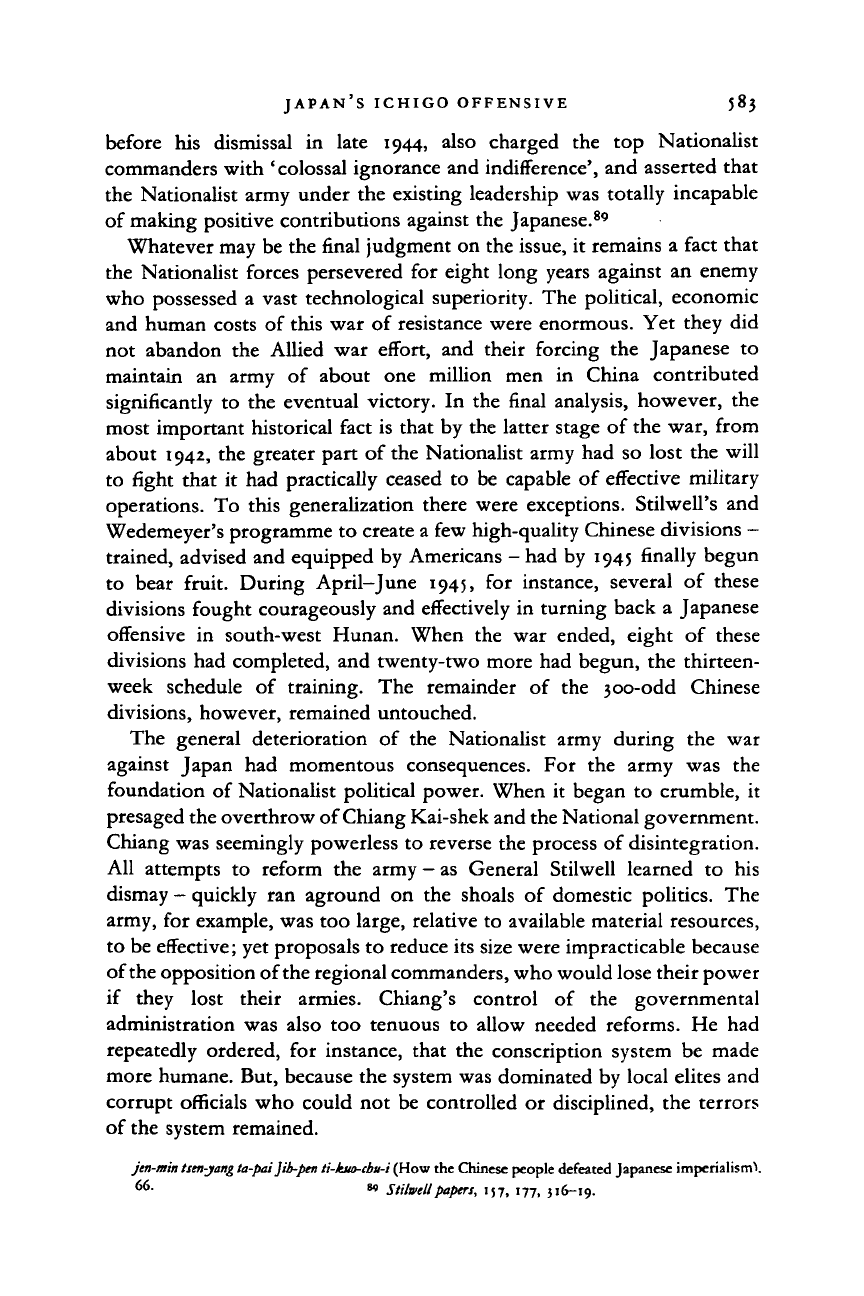
JAPAN'S ICHIGO OFFENSIVE 583
before his dismissal in late 1944, also charged the top Nationalist
commanders with
'
colossal ignorance and indifference', and asserted that
the Nationalist army under the existing leadership was totally incapable
of making positive contributions against the Japanese.
89
Whatever may be the final judgment on the issue, it remains a fact that
the Nationalist forces persevered for eight long years against an enemy
who possessed a vast technological superiority. The political, economic
and human costs of this war of resistance were enormous. Yet they did
not abandon the Allied war effort, and their forcing the Japanese to
maintain an army of about one million men in China contributed
significantly to the eventual victory. In the final analysis, however, the
most important historical fact is that by the latter stage of the war, from
about 1942, the greater part of the Nationalist army had so lost the will
to fight that it had practically ceased to be capable of effective military
operations. To this generalization there were exceptions. Stilwell's and
Wedemeyer's programme to create a few high-quality Chinese divisions -
trained, advised and equipped by Americans - had by 1945 finally begun
to bear fruit. During April-June 1945, for instance, several of these
divisions fought courageously and effectively in turning back a Japanese
offensive in south-west Hunan. When the war ended, eight of these
divisions had completed, and twenty-two more had begun, the thirteen-
week schedule of training. The remainder of the 300-odd Chinese
divisions, however, remained untouched.
The general deterioration of the Nationalist army during the war
against Japan had momentous consequences. For the army was the
foundation of Nationalist political power. When it began to crumble, it
presaged the overthrow of Chiang Kai-shek and the National government.
Chiang was seemingly powerless to reverse the process of disintegration.
All attempts to reform the army
—
as General Stilwell learned to his
dismay
—
quickly ran aground on the shoals of domestic politics. The
army, for example, was too large, relative to available material resources,
to be effective; yet proposals to reduce its size were impracticable because
of the opposition of the regional commanders, who would lose their power
if they lost their armies. Chiang's control of the governmental
administration was also too tenuous to allow needed reforms. He had
repeatedly ordered, for instance, that the conscription system be made
more humane. But, because the system was dominated by local elites and
corrupt officials who could not be controlled or disciplined, the terrors
of the system remained.
jen-min tsen-jang ta-pai Jib-pm ti-kuo-cbu-i (How the Chinese people defeated Japanese imperialism^
66
-
M
Stilwell papers, 157, 177, 516-19.
Cambridge Histories Online © Cambridge University Press, 2008
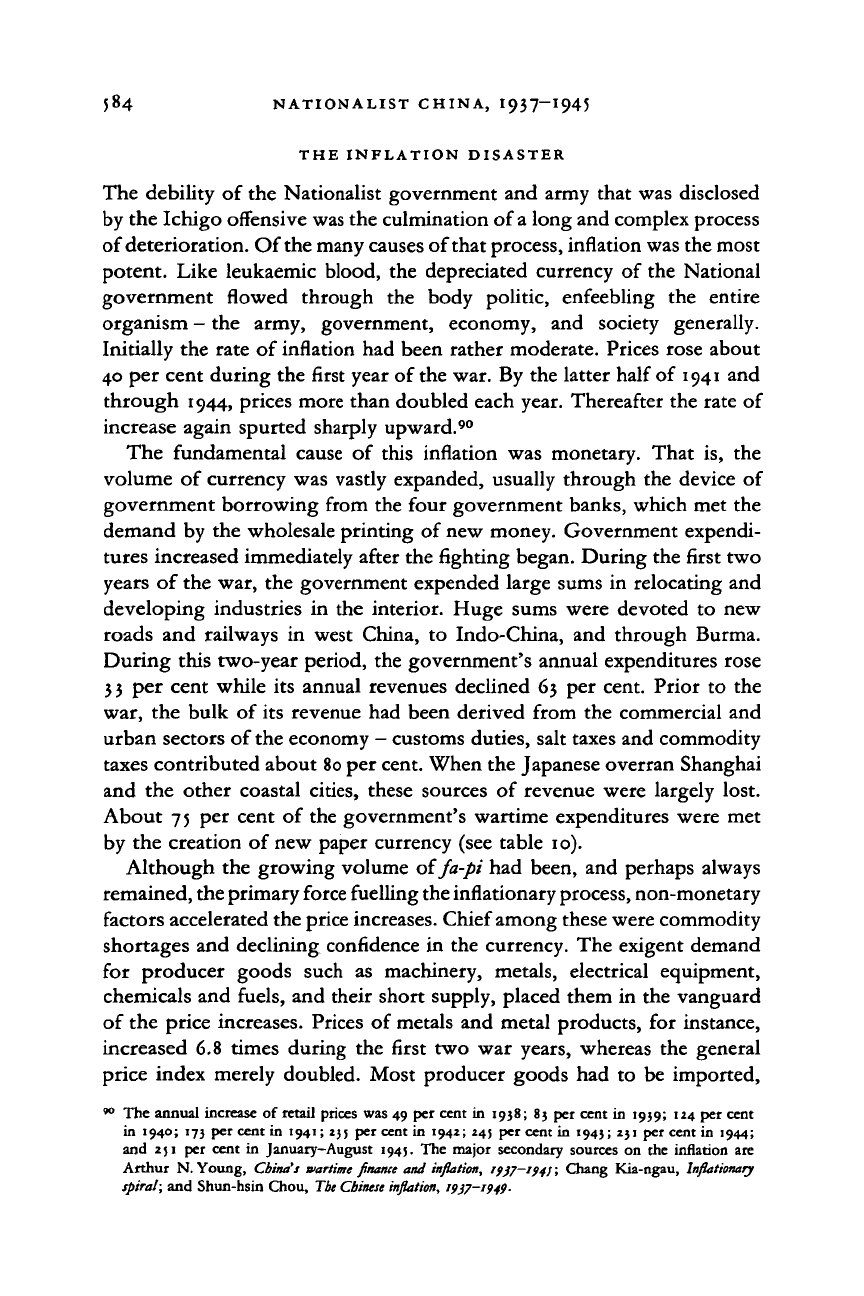
584 NATIONALIST CHINA, I937-I945
THE INFLATION DISASTER
The debility
of
the Nationalist government and army that was disclosed
by the Ichigo offensive was the culmination of a long and complex process
of deterioration. Of the many causes of that process, inflation was the most
potent. Like leukaemic blood, the depreciated currency
of
the National
government flowed through
the
body politic, enfeebling
the
entire
organism
—
the army, government, economy,
and
society generally.
Initially the rate
of
inflation had been rather moderate. Prices rose about
40 per cent during the first year of the war. By the latter half of 1941 and
through 1944, prices more than doubled each year. Thereafter the rate of
increase again spurted sharply upward.
90
The fundamental cause
of
this inflation was monetary. That is,
the
volume
of
currency was vastly expanded, usually through the device of
government borrowing from the four government banks, which met the
demand by the wholesale printing of new money. Government expendi-
tures increased immediately after the fighting began. During the
first
two
years
of
the war, the government expended large sums in relocating and
developing industries
in
the interior. Huge sums were devoted
to
new
roads and railways
in
west China,
to
Indo-China, and through Burma.
During this two-year period, the government's annual expenditures rose
33 per cent while its annual revenues declined 63 per cent. Prior
to
the
war, the bulk
of
its revenue had been derived from the commercial and
urban sectors of the economy
-
customs duties, salt taxes and commodity
taxes contributed about
80
per cent. When the Japanese overran Shanghai
and
the
other coastal cities, these sources
of
revenue were largely lost.
About 75 per cent
of
the government's wartime expenditures were met
by the creation
of
new paper currency (see table 10).
Although the growing volume of fa-pi had been, and perhaps always
remained, the primary force fuelling the inflationary
process,
non-monetary
factors accelerated the price increases. Chief among these were commodity
shortages and declining confidence in the currency. The exigent demand
for producer goods such
as
machinery, metals, electrical equipment,
chemicals and fuels, and their short supply, placed them in the vanguard
of the price increases. Prices of metals and metal products, for instance,
increased 6.8 times during the first two war years, whereas the general
price index merely doubled. Most producer goods had
to
be imported,
90
The annual increase
of
retail prices was 49 per cent in 1938; 83 per cent in 1939; 124 per cent
in 1940; 173 per cent in 1941; 23; per cent in 1942; 24; per cent in 1943; 231 per cent in 1944;
and 251 per cent
in
January-August 194;. The major secondary sources on the inflation are
Arthur N. Young, China's wartime finance and inflation, 19)7—1941; Chang Kia-ngau, Inflationary
spiral; and Shun-hsin Chou, The Chinese inflation,
1937—1949-
Cambridge Histories Online © Cambridge University Press, 2008
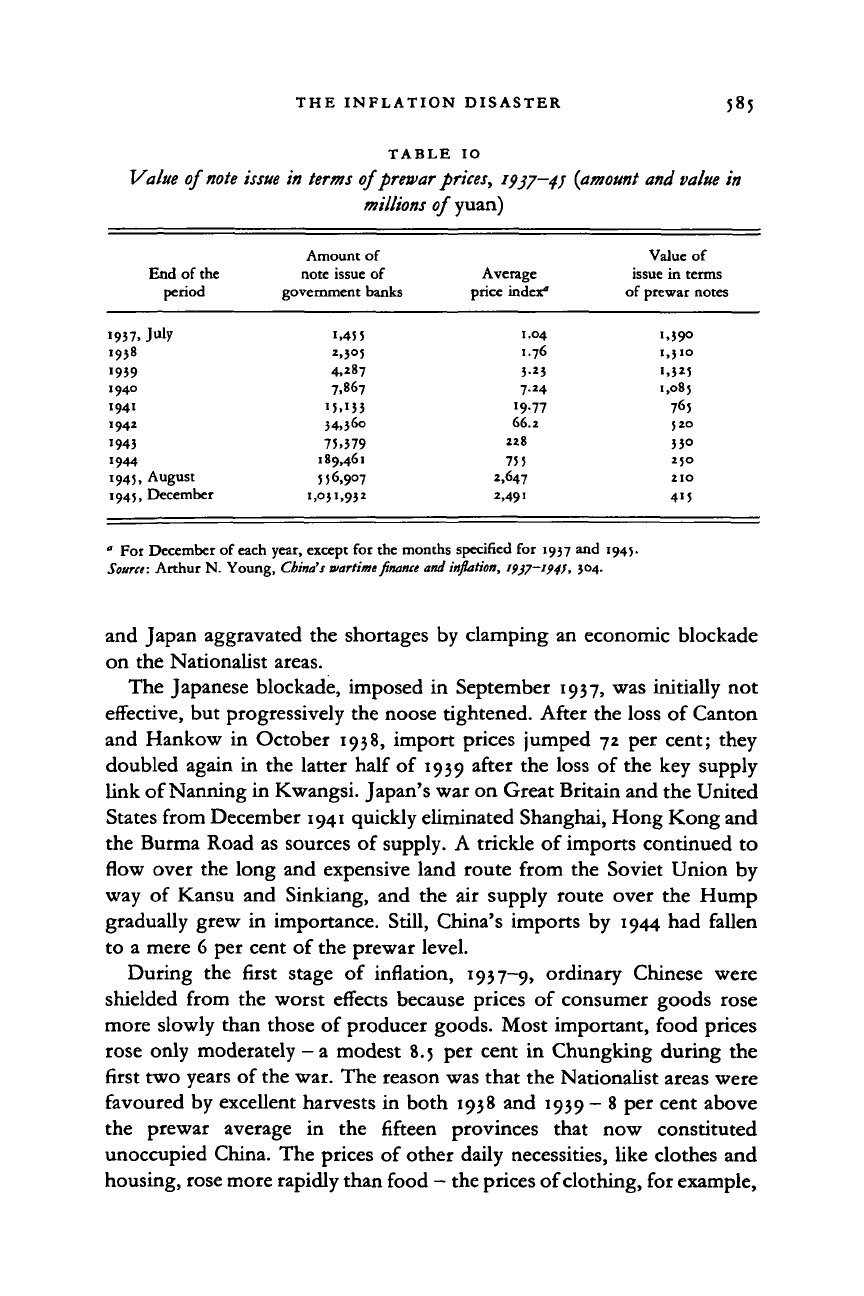
THE INFLATION DISASTER
585
TABLE
IO
Value
of
note issue
in
terms of prewar
prices,
1957-4) {amount and
value
in
millions
of
yuan)
End of the
period
1937. July
1938
'939
1940
1941
1942
'943
1944
1945,
August
1945,
December
Amount
of
note issue
of
government banks
J.45 5
*.3°5
4.287
7,867
"5,133
34,36o
75.379
189,461
556,907
',031.932
Average
price index*
1.04
1.76
3-23
7-24
'9-77
66.2
228
75 5
2.647
2,491
Value of
issue in terms
of prewar notes
',39°
1,310
',325
1,085
765
520
33°
2JO
2IO
4'5
° For December of each year, except for the months specified for 1937 and 1945.
Source: Arthur
N.
Young, China's wartime finance and
inflation,
1937—194},
304.
and Japan aggravated
the
shortages
by
clamping
an
economic blockade
on
the
Nationalist areas.
The Japanese blockade, imposed
in
September 1937,
was
initially
not
effective,
but
progressively
the
noose tightened. After
the
loss
of
Canton
and Hankow
in
October 1938, import prices jumped
72 per
cent; they
doubled again
in the
latter half
of
1939 after
the
loss
of
the
key
supply
link of Nanning
in
Kwangsi. Japan's war
on
Great Britain
and the
United
States from December 1941 quickly eliminated Shanghai, Hong Kong and
the Burma Road
as
sources
of
supply.
A
trickle
of
imports continued
to
flow over
the
long
and
expensive land route from
the
Soviet Union
by
way
of
Kansu
and
Sinkiang,
and the air
supply route over
the
Hump
gradually grew
in
importance. Still, China's imports
by
1944
had
fallen
to
a
mere
6 per
cent
of
the prewar level.
During
the
first stage
of
inflation, 1937-9, ordinary Chinese were
shielded from
the
worst effects because prices
of
consumer goods rose
more slowly than those
of
producer goods. Most important, food prices
rose only moderately-a modest
8.5 per
cent
in
Chungking during
the
first two years
of
the war.
The
reason was that
the
Nationalist areas were
favoured
by
excellent harvests
in
both 1938
and
1939-8
per
cent above
the prewar average
in the
fifteen provinces that
now
constituted
unoccupied China.
The
prices
of
other daily necessities, like clothes
and
housing, rose more rapidly than food
-
the prices of clothing,
for
example,
Cambridge Histories Online © Cambridge University Press, 2008
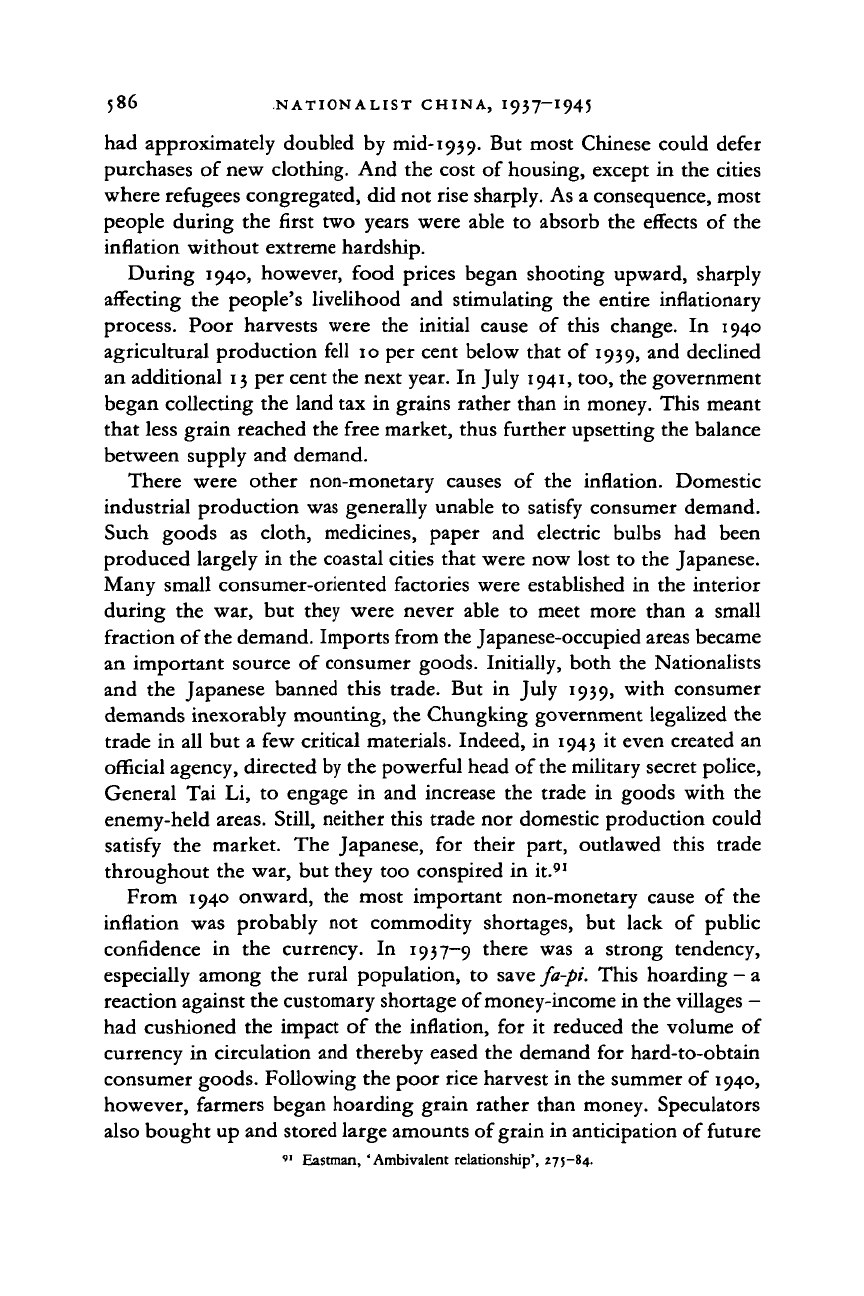
586 NATIONALIST CHINA, I937-I945
had approximately doubled by mid-1939. But most Chinese could defer
purchases of new clothing. And the cost of housing, except in the cities
where refugees congregated, did not rise sharply. As a consequence, most
people during the first two years were able
to
absorb the effects
of
the
inflation without extreme hardship.
During 1940, however, food prices began shooting upward, sharply
affecting the people's livelihood and stimulating the entire inflationary
process. Poor harvests were
the
initial cause
of
this change.
In
1940
agricultural production fell 10 per cent below that
of
1939, and declined
an additional 13 per cent the next year. In July
1941,
too, the government
began collecting the land tax in grains rather than in money. This meant
that less grain reached the free market, thus further upsetting the balance
between supply and demand.
There were other non-monetary causes
of
the inflation. Domestic
industrial production was generally unable
to
satisfy consumer demand.
Such goods
as
cloth, medicines, paper
and
electric bulbs
had
been
produced largely in the coastal cities that were now lost to the Japanese.
Many small consumer-oriented factories were established
in
the interior
during the war,
but
they were never able
to
meet more than
a
small
fraction of the demand. Imports from the Japanese-occupied areas became
an important source
of
consumer goods. Initially, both the Nationalists
and the Japanese banned this trade. But
in
July 1939, with consumer
demands inexorably mounting, the Chungking government legalized the
trade in all but a few critical materials. Indeed, in 1943 it even created an
official agency, directed by the powerful head of
the
military secret police,
General Tai Li,
to
engage
in
and increase the trade
in
goods with the
enemy-held areas. Still, neither this trade nor domestic production could
satisfy
the
market. The Japanese,
for
their part, outlawed this trade
throughout the war, but they too conspired
in
it.
91
From 1940 onward, the most important non-monetary cause
of
the
inflation was probably
not
commodity shortages,
but
lack
of
public
confidence
in the
currency.
In
1937-9 there was
a
strong tendency,
especially among the rural population,
to
save fa-pi. This hoarding
-
a
reaction against the customary shortage of money-income in the villages
-
had cushioned the impact
of
the inflation, for
it
reduced the volume
of
currency in circulation and thereby eased the demand for hard-to-obtain
consumer goods. Following the poor rice harvest in the summer
of
1940,
however, farmers began hoarding grain rather than money. Speculators
also bought up and stored large amounts of grain in anticipation of future
" Eastman, 'Ambivalent relationship', 275-84.
Cambridge Histories Online © Cambridge University Press, 2008
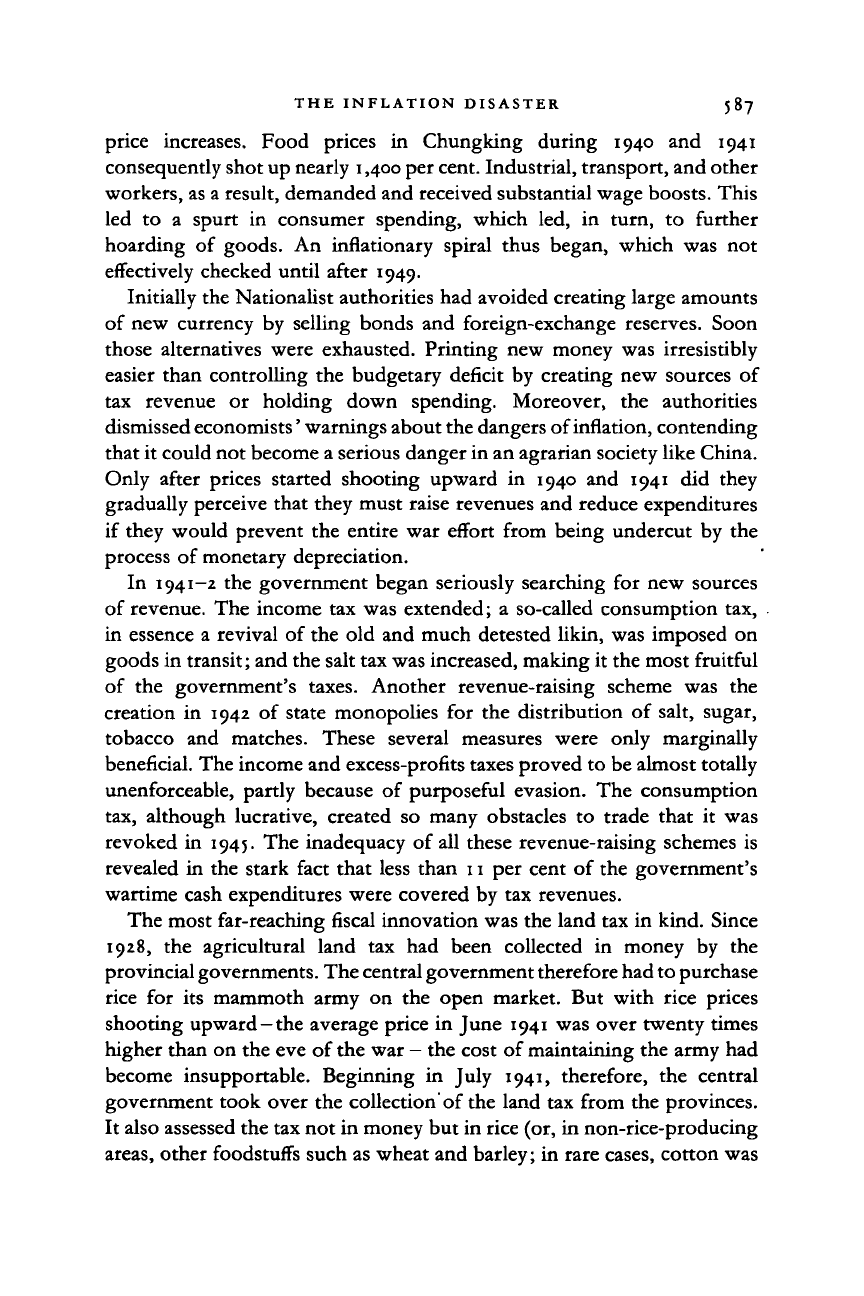
THE INFLATION DISASTER 587
price increases. Food prices in Chungking during 1940 and 1941
consequently shot up nearly 1,400 per cent. Industrial, transport, and other
workers, as a result, demanded and received substantial wage boosts. This
led to a spurt in consumer spending, which led, in turn, to further
hoarding of goods. An inflationary spiral thus began, which was not
effectively checked until after 1949.
Initially the Nationalist authorities had avoided creating large amounts
of new currency by selling bonds and foreign-exchange reserves. Soon
those alternatives were exhausted. Printing new money was irresistibly
easier than controlling the budgetary deficit by creating new sources of
tax revenue or holding down spending. Moreover, the authorities
dismissed economists' warnings about the dangers of inflation, contending
that it could not become a serious danger in an agrarian society like China.
Only after prices started shooting upward in 1940 and 1941 did they
gradually perceive that they must raise revenues and reduce expenditures
if they would prevent the entire war effort from being undercut by the
process of monetary depreciation.
In 1941—2 the government began seriously searching for new sources
of revenue. The income tax was extended; a so-called consumption tax,
in essence a revival of the old and much detested likin, was imposed on
goods in transit; and the salt tax was increased, making it the most fruitful
of the government's taxes. Another revenue-raising scheme was the
creation in 1942 of state monopolies for the distribution of salt, sugar,
tobacco and matches. These several measures were only marginally
beneficial. The income and excess-profits taxes proved to be almost totally
unenforceable, partly because of purposeful evasion. The consumption
tax, although lucrative, created so many obstacles to trade that it was
revoked in 1945. The inadequacy of all these revenue-raising schemes is
revealed in the stark fact that less than 11 per cent of the government's
wartime cash expenditures were covered by tax revenues.
The most far-reaching fiscal innovation was the land tax in kind. Since
1928,
the agricultural land tax had been collected in money by the
provincial
governments.
The central government therefore had to purchase
rice for its mammoth army on the open market. But with rice prices
shooting upward —the average price in June 1941 was over twenty times
higher than on the eve of the war - the cost of maintaining the army had
become insupportable. Beginning in July 1941, therefore, the central
government took over the collection of the land tax from the provinces.
It also assessed the tax not in money but in rice (or, in non-rice-producing
areas,
other foodstuffs such as wheat and barley; in rare cases, cotton was
Cambridge Histories Online © Cambridge University Press, 2008
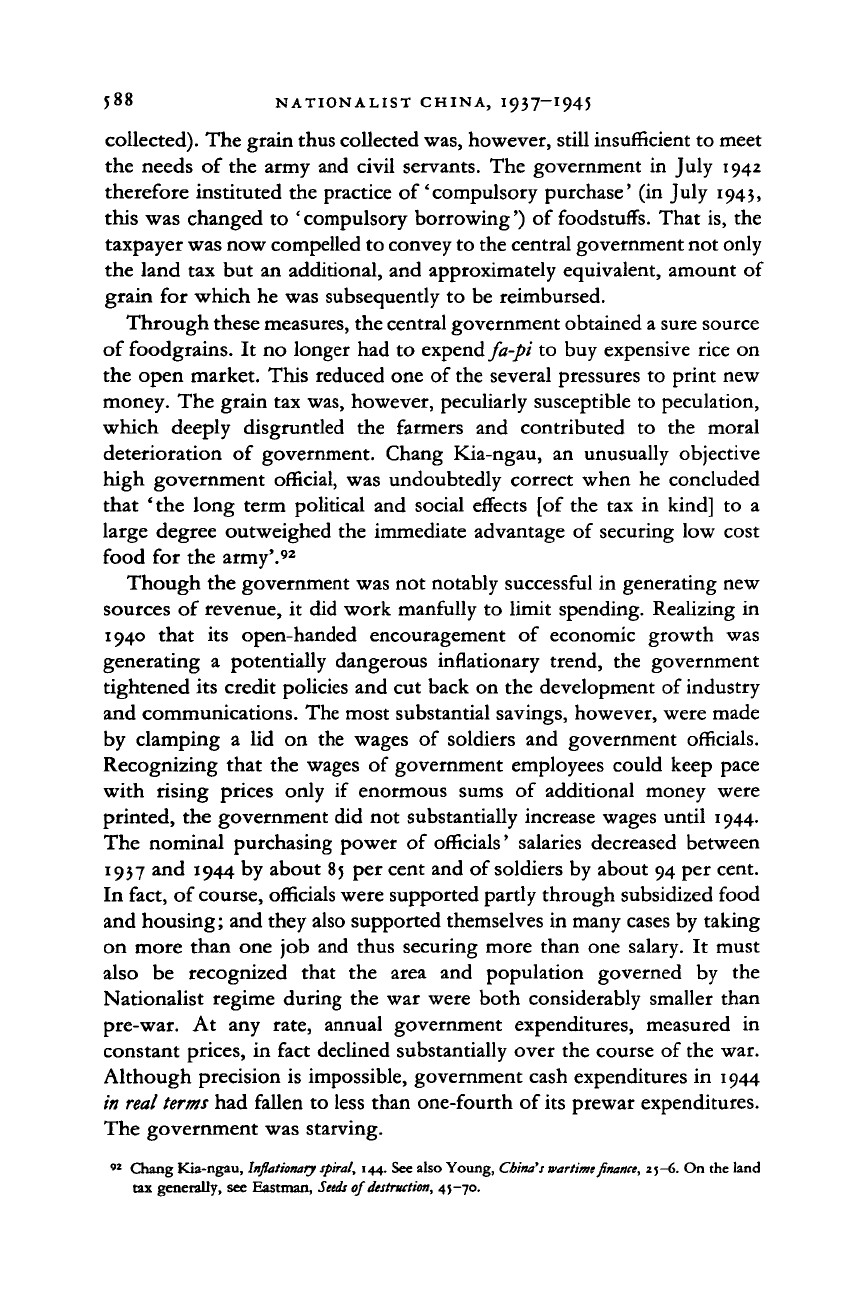
588 NATIONALIST CHINA, 1937-1945
collected). The grain thus collected was, however, still insufficient to meet
the needs of the army and civil servants. The government in July 1942
therefore instituted the practice of'compulsory purchase' (in July 1943,
this was changed to ' compulsory borrowing') of foodstuffs. That is, the
taxpayer was now compelled to convey to the central government not only
the land tax but an additional, and approximately equivalent, amount of
grain for which he was subsequently to be reimbursed.
Through these measures, the central government obtained a sure source
of foodgrains. It no longer had to expend fa-pi to buy expensive rice on
the open market. This reduced one of the several pressures to print new
money. The grain tax was, however, peculiarly susceptible to peculation,
which deeply disgruntled the farmers and contributed
to
the moral
deterioration of government. Chang Kia-ngau, an unusually objective
high government official, was undoubtedly correct when he concluded
that ' the long term political and social effects [of the tax in kind] to
a
large degree outweighed the immediate advantage of securing low cost
food for the army'.
92
Though the government was not notably successful in generating new
sources of revenue, it did work manfully to limit spending. Realizing in
1940 that
its
open-handed encouragement
of
economic growth was
generating
a
potentially dangerous inflationary trend, the government
tightened its credit policies and cut back on the development of industry
and communications. The most substantial savings, however, were made
by clamping
a
lid on the wages
of
soldiers and government officials.
Recognizing that the wages of government employees could keep pace
with rising prices only
if
enormous sums
of
additional money were
printed, the government did not substantially increase wages until 1944.
The nominal purchasing power of officials' salaries decreased between
1937 and 1944 by about 85 per cent and of soldiers by about 94 per cent.
In fact, of course, officials were supported partly through subsidized food
and housing; and they also supported themselves in many cases by taking
on more than one job and thus securing more than one salary. It must
also
be
recognized that the area and population governed
by the
Nationalist regime during the war were both considerably smaller than
pre-war.
At
any rate, annual government expenditures, measured
in
constant prices, in fact declined substantially over the course of the war.
Although precision is impossible, government cash expenditures in 1944
in
real terms
had fallen to less than one-fourth of its prewar expenditures.
The government was starving.
n
Chang Kia-ngau, Inflationary spiral, 144. See also Young, China's wartime finance, 25-6. On the land
tax generally, see Eastman,
Seeds
of destruction, 45-70.
Cambridge Histories Online © Cambridge University Press, 2008
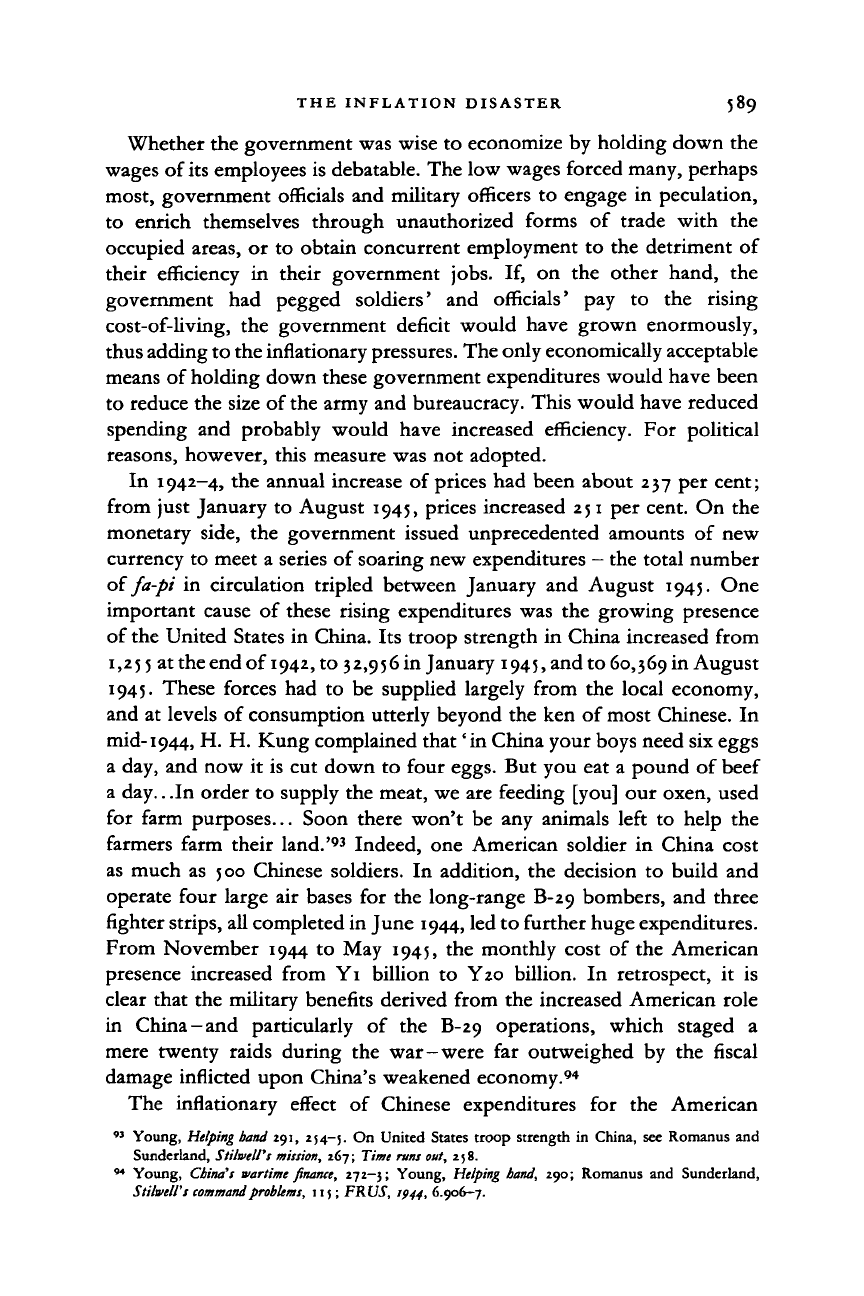
THE INFLATION DISASTER 589
Whether the government was wise to economize by holding down the
wages of
its
employees is debatable. The low wages forced many, perhaps
most, government officials and military officers to engage in peculation,
to enrich themselves through unauthorized forms
of
trade with the
occupied areas, or to obtain concurrent employment to the detriment of
their efficiency
in
their government jobs.
If,
on the other hand, the
government had pegged soldiers' and officials' pay
to the
rising
cost-of-living, the government deficit would have grown enormously,
thus adding to the inflationary pressures. The only economically acceptable
means of holding down these government expenditures would have been
to reduce the size of the army and bureaucracy. This would have reduced
spending and probably would have increased efficiency. For political
reasons, however, this measure was not adopted.
In 1942-4, the annual increase of prices had been about 237 per cent;
from just January to August 1945, prices increased 251 per cent. On the
monetary side, the government issued unprecedented amounts of new
currency to meet a series of soaring new expenditures
—
the total number
of fa-pi in circulation tripled between January and August 1945. One
important cause of these rising expenditures was the growing presence
of the United States in China. Its troop strength in China increased from
1,255 at the end of
1942,
to 32,956 m January
1945,
and
1060,369^1
August
1945.
These forces had to be supplied largely from the local economy,
and at levels of consumption utterly beyond the ken of most Chinese. In
mid-1944, H. H. Kung complained that 'in China your boys need six eggs
a day, and now it is cut down to four eggs. But you eat a pound of beef
a day.. .In order to supply the meat, we are feeding [you] our oxen, used
for farm purposes... Soon there won't be any animals left to help the
farmers farm their land.'
93
Indeed, one American soldier in China cost
as much as 500 Chinese soldiers. In addition, the decision to build and
operate four large air bases for the long-range B-29 bombers, and three
fighter
strips,
all completed in June 1944, led to further huge expenditures.
From November 1944 to May 1945, the monthly cost of the American
presence increased from Yi billion to Y20 billion. In retrospect,
it is
clear that the military benefits derived from the increased American role
in China-and particularly
of
the B-29 operations, which staged
a
mere twenty raids during the war-were far outweighed by the fiscal
damage inflicted upon China's weakened economy.
04
The inflationary effect
of
Chinese expenditures
for
the American
93
Young,
Helping band
291,
254-5.
On
United States troop strength
in
China,
see
Romanus
and
Sunderland, Stilwell's mission, 267; Time runs out, 258.
94
Young, China's wartime finance,
272—3;
Young, Helping
band,
290; Romanus and Sunderland,
Stilwell's command problems, 115; FRUS, 1944, 6.906-7.
Cambridge Histories Online © Cambridge University Press, 2008
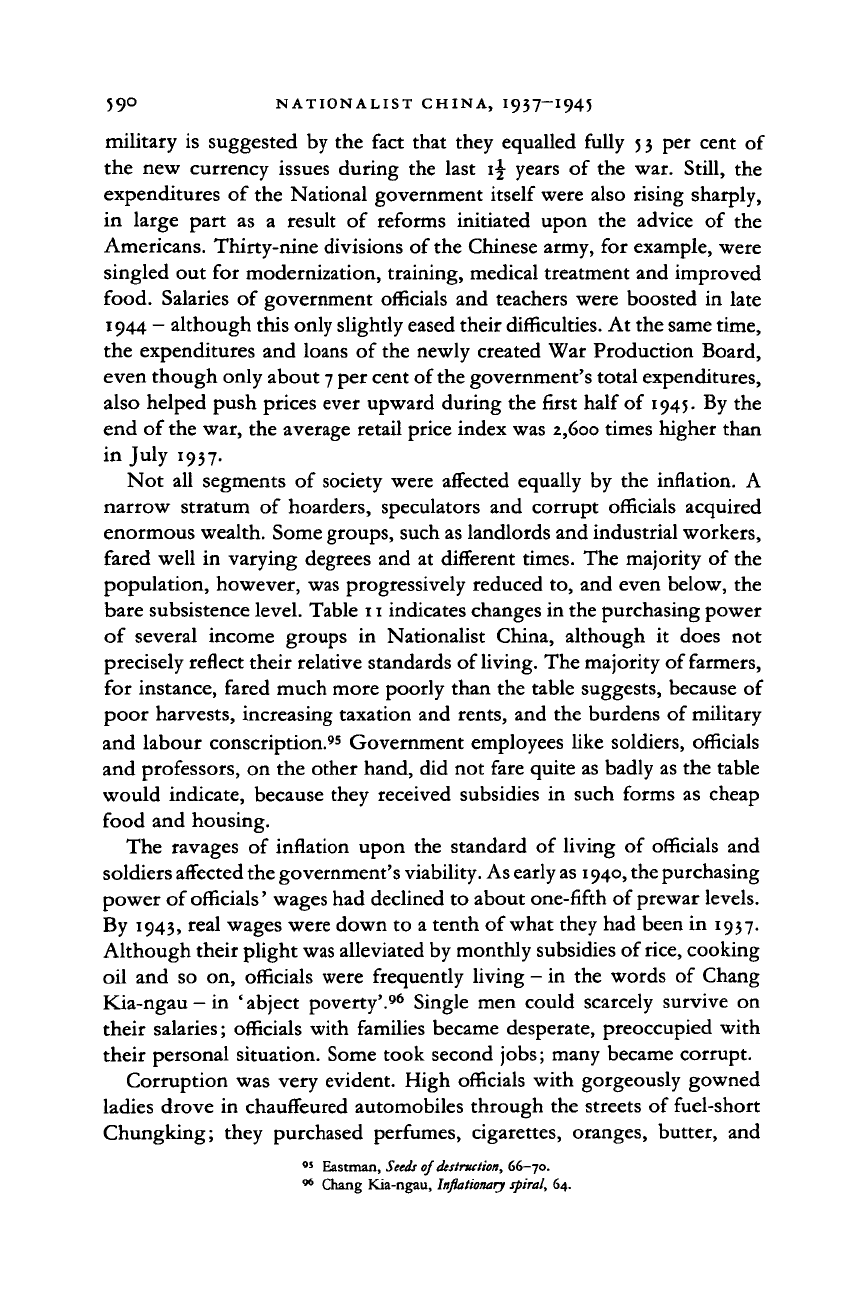
59° NATIONALIST CHINA, I937-I945
military is suggested by the fact that they equalled fully
5 3
per cent of
the new currency issues during the last
\\
years
of
the war. Still, the
expenditures of the National government itself were also rising sharply,
in large part
as a
result
of
reforms initiated upon the advice
of
the
Americans. Thirty-nine divisions of the Chinese army, for example, were
singled out for modernization, training, medical treatment and improved
food. Salaries of government officials and teachers were boosted in late
1944
-
although this only slightly eased their difficulties. At the same time,
the expenditures and loans of the newly created War Production Board,
even though only about
7
per cent of the government's total expenditures,
also helped push prices ever upward during the first half of 1945. By the
end of the war, the average retail price index was 2,600 times higher than
in July 1937.
Not all segments
of
society were affected equally by the inflation.
A
narrow stratum
of
hoarders, speculators and corrupt officials acquired
enormous wealth. Some groups, such as landlords and industrial workers,
fared well in varying degrees and at different times. The majority of the
population, however, was progressively reduced to, and even below, the
bare subsistence level. Table
11
indicates changes in the purchasing power
of several income groups
in
Nationalist China, although
it
does not
precisely reflect their relative standards of
living.
The majority of farmers,
for instance, fared much more poorly than the table suggests, because of
poor harvests, increasing taxation and rents, and the burdens of military
and labour conscription.
95
Government employees like soldiers, officials
and professors, on the other hand, did not fare quite as badly as the table
would indicate, because they received subsidies
in
such forms as cheap
food and housing.
The ravages
of
inflation upon the standard of living
of
officials and
soldiers affected the government's viability.
As
early
as 1940,
the purchasing
power of officials' wages had declined to about one-fifth of prewar levels.
By 1943, real wages were down to a tenth of what they had been in 1937.
Although their plight was alleviated by monthly subsidies of
rice,
cooking
oil and so on, officials were frequently living
-
in the words
of
Chang
Kia-ngau
-
in 'abject poverty'.
06
Single men could scarcely survive on
their salaries; officials with families became desperate, preoccupied with
their personal situation. Some took second jobs; many became corrupt.
Corruption was very evident. High officials with gorgeously gowned
ladies drove in chauffeured automobiles through the streets of fuel-short
Chungking; they purchased perfumes, cigarettes, oranges, butter, and
95
Eastman, Seeds of
destruction,
66—70.
96
Chang Kia-ngau, Inflationary spiral, 64.
Cambridge Histories Online © Cambridge University Press, 2008
